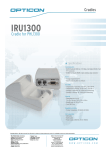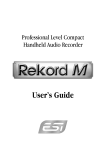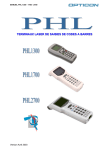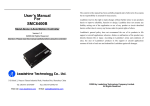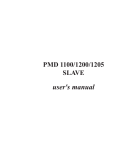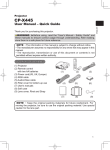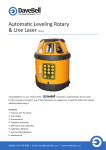Download User's Manual - Opticon-SHOP
Transcript
User’s Manual Pocket Terminal PHL1300 Cradle IRU1300 USER’S MANUAL PHL1300 TERMINAL / IRU1300 CRADLE CAUTION: This user’s manual may be revised or withdrawn at any time without prior notice. Copyright 2002, Opticon Sensors Europe B.V. All rights reserved. This manual may not, in whole or in part, be copied, photocopied, reproduced, translated or converted to any electronic or machine readable form without prior written consent of Opticon Sensors Europe. Limited warranty and disclaimers By opening the package of this product you agree to become bound by the liability and warranty conditions as described below. Under all circumstances this manual should be read attentively, before installing and or using the product. In no event, Opticon Sensors Europe will be liable for any direct, indirect, consequential or incidental damages arising out of use or inability to use both the hardware and software, even if Opticon has been informed about the possibility of such damages. A serial number appears on all Opticon products. This official registration number is strictly related to the device purchased. Make sure that the serial number appearing on your Opticon device has not been removed. Servicing by our Repair Department can only be carried out under warranty. All Opticon products are warranted for the legal warranty period after purchase, covering defects in material and workmanship. Opticon will repair or, at its opinion, replace products that prove to be defective in material or workmanship under proper use during the warranty period. Opticon will not be liable in case modifications are made by the customer. In such case the standard repair charge will be applicable. The standard charge for repair will also be applicable in case no defect is found at all. These rules also apply for products that are still under warranty. Therefore, you are advised to have the product specifications always at hand. Trademarks used are property of their respective owners The general use and functioning of the terminal together with the cradle will be described in this manual. The exact behavior of the terminal depends on the user application that is running. For instructions about applications please consult the documentation of that software. Please read this manual carefully before using the terminal, to maximise the efficiency of this terminal. PHL1300-ver1 / printed 04 2002 USER’S MANUAL PHL1300 TERMINAL / IRU1300 CRADLE CONTENTS page page 1 INTRODUCTION 4 5 PIN OUT 17 2 INSTALLATION 5 5.1 5.2 RS232 cable for cradle RS485 cable for cradle network 17 17 2.1 UNPACKING 5 6 SPECIFICATIONS 18 2.2 2.2.1 2.2.2 2.2.3 2.2.4 DETAILED VIEW Dimensions of terminal Details of terminal Dimensions of cradle Details of cradle 6 6 7 8 8 2.3 HANDLING 9 6.1 6.1.1 6.1.2 6.1.3 6.1.4 6.1.5 6.1.6 SPECIFICATIONS TERMINAL Electrical specifications Optical specifications Supported symbologies Functionality Environmental specifications Physical specifications 18 18 18 18 18 19 19 2.4 2.4.1 2.4.2 2.4.3 ASSEMBLY Terminal Cradle Terminal on cradle 2.5 INSTALLING, 6.2 6.2.1 6.2.2 6.2.3 6.2.4 SPECIFICATION CRADLE Electrical specifications Functionality Environmental specifications Physical specifications 19 19 19 19 19 7 TROUBLESHOOTING 20 7.1 7.2 7.3 COMMUNICATION PROBLEMS READ OPERATION PROBLEMS TERMINAL PROBLEMS 21 21 22 8 PRODUCT ORDERING INFORMATION 23 PRECAUTIONS 10 10 10 10 REPLACING AND CHARGING 11 Required batteries 12 How to charge the rechargeable battery pack in the cradle? 12 When to replace or recharge the main battery? 12 When to replace the backup battery? 12 How to (re)place the main battery in the terminal? 12 How to (re)place the backup battery in the terminal? 13 BATTERIES 2.5.1 2.5.2 2.5.3 2.5.4 2.5.5 2.5.6 2.6 2.6.1 2.6.2 2.6.3 INSTALLING IN A SYSTEM Single cradle Cradle network Dip switch settings on cradle 14 14 14 15 3 OPERATION OF THE TERMINAL 15 4 SCANNING 16 4.1 4.2 How to read the barcode Barcode reading problems 16 16 3 USER’S MANUAL PHL1300 TERMINAL / IRU1300 CRADLE 3 1 INTRODUCTION This terminal is a pocket sized, programmable handheld terminal, and is well suited for a variety of portable applications. It has a built-in laser scanner that can scan all popular bar code labels at varying distances. User’s applications can be downloaded to the terminal to adapt the terminal to the user’s situation. Operating power is supplied by the main battery. The main battery may consist of a rechargeable Li-Ion battery pack as supplied with the terminal, or regular AA-size dry cell batteries. The cradle is a communication station for data transmission between the (host) computer system and the terminal. It communicates with the terminal through their IrDA interface. The cradle will also charge the rechargeable battery pack in the terminal through the electrical contacts. The IrDA interface on the terminal enables you to communicate with other devices that use IrDA communication, like portable computers, notebooks and organisers. 4 USER’S MANUAL PHL1300 TERMINAL / IRU1300 CRADLE 3 2 PHL1300: IRU1300: Terminal Cradle INSTALLATION 2.1 UNPACKING When you remove the packing, please check for any physical damage. We recommend that you save all packing material, as it should be used whenever you need to ship your terminal (eg. for service). Damage due to improper repacking is not covered by the warranty. ADDITIONAL IRU1300: Backup battery Power Supply Handstrap RS232 cable DB9 F Apart from the terminal or cradle, additional items might be ordered and supplied. If there are any missing parts please contact your supplier. Do not remove the label ! On the back of every unit you will find a label. The label is attached by the manufacturer and includes information about the function it supports and a serial number. Do not remove it. RS485 network cable ADDITIONAL PHL1300: Battery pack 5 USER’S MANUAL PHL1300 TERMINAL / IRU1300 CRADLE 2.2 DETAILED VIEW 2.2.1 Dimensions of terminal 33 mm 55 mm 132 mm 1 2 3 11 4 6 7 5 8 12 9 10 13 14 15 6 USER’S MANUAL PHL1300 TERMINAL / IRU1300 CRADLE 2.2.2 Details of terminal: 1. Reading window laser beam for barcode reading will be emitted from here 9. Character keys definable by application typical use: for input of alpha-numeric and punctuation characters 2. LCD Display for displaying information 10. ENT key definable by application typical use: for confirming input Main Battery indicator Full. 2/3. 11. Backup battery case cover for housing backup battery 1/3. Low. Replace immediately. Backup Battery indicator Off: Sufficient battery power On: Battery low. Replace immediately. Alpha mode on (Shift-key activated) Backlight of LCD Display When the backlight is turned on, the power consumption increases. To extend the life time of your batteries use the backlight as little as possible. 12. Main battery case cover for housing main battery 13. Hand strap pillar for attaching hand strap 14. Optical interface window for infra red communication 15. Electrical contacts for power supply from the cradle IRU1300 to terminal 3. LED indicator can be used to indicate results, for example bar code reading / status of communication 4. Buzzer auditive indicator 5. Power key for switching power On/Off 6. Trigger key definable by application typical use: read key, switches laser beam on for barcode reading 7. Quick keys definable by application typical use: menu scroll keys or yes/no input 8. Control keys definable by application for controlling basic functions typical use as below: CLR : Cancel input BS : Back space S : Shift key “S”on the LCD display indicates the terminal is in the shift mode 7 USER’S MANUAL PHL1300 TERMINAL / IRU1300 CRADLE 2.2.3 Dimensions of cradle 75 mm 2.2.4 Details of cradle 78 mm 1. DC input socket input for AC adaptor 134 mm 2. RS 485 socket for connecting another cradle in multidrop RS485 network, through Opticon RS485 cable 3. RS 232 C socket for connecting to PC or modem, through Opticon RS232 cable 4. DIP switches setting parameters of the infrared interface. 5. Electrical contacts for power supply to terminal PHL1300 If rechargeable Li-Ion battery pack is inserted in the terminal the pack will be charged through the electrical contacts 6. Optical window window for optical data transmission 1 2 3 1 4 5 6 7 8 7. LED indicator indicating power LED on: power is on LED off: power is off USER’S MANUAL PHL1300 TERMINAL / IRU1300 CRADLE 2.3 HANDLING PRECAUTIONS Use of the terminal Avoid temperature changes. Sudden temperature changes can cause condensation to form on the terminal. Using the terminal while condensation is present can cause malfunction. Always wait until the condensation clears naturally before attempting operation. To avoid malfunctioning and to ensure years of trouble free operation, pay attention to the following: General use Do not use or leave the product in extremely hot areas - like direct sunlight, near a heater, or in a car - or in areas that are very cold, humid, moistured or dusty. Do not leave the terminal in an area where static charge is accumulated, or near devices where electromagnetic emission is generated. Do not expose the product to rain or water splash. Do not subject the the product to very strong impact, do not throw or drop the terminal from large heights. ! ! Do not allow a mechanical shock to the product. Cleaning instructions Clean the exterior by wiping it with a soft, dry cloth. Do not use much water. Do not use thinner, white spirit or other solvents. These can discolour the case and the keys and has a negative effect on the lifetime of the keys. Cleaning of the terminal Clean the optical interface window periodically. Cleaning of the cradle Avoid touching the contacts in the cradle. The contacts must stay as clean as possible to maintain optimal charging capacity. Do not use water when cleaning the cradle. This can cause malfunction in the chargers. Do not place any objects on top of the terminal. Do not lay the terminal face down. Doing so can cause accidental operation of the [PW] key or [ENTER] key, which can discharge your batteries or change settings you do not want to be changed. Use of the cradle Do not place any other product than the PHL-type terminal in the cradle. Maintenance There are no user-serviceable parts inside the terminal or the cradle. So do not try to take it apart. The manufacturer will not be liable for any damage caused by the customer. In case of malfunction that can not be solved by the trouble-shooting instruction in the appendix, please consult our service department. 9 USER’S MANUAL PHL1300 TERMINAL / IRU1300 CRADLE 2.4.2 Cradle 2.4 ASSEMBLY Place for mounting Follow the next steps to make your terminal ready for installation in a system, that is described further in the manual. 2.4.1. Terminal Place the cradle in normal office conditions. Avoid a place under strong light. Otherwise IrDA communication may be disturbed. To avoid drop use the hand strap. Power Connection Fix the small cord of the strap around the pillar of the terminal (ref. 1) Insert the handle of the strap in the thin loop (ref. 2) The strap is fixed to the terminal (ref. 3) Hold the handstrap around the wrist when carrying the terminal (ref. 4) ! Do not swing the terminal around. Attach the DC jack of the AC adapter into the socket of the cradle. Then connect the AC adapter to the mains outlet When the terminal PHL1300 with the rechargeable battery pack is placed in the cradle, the LED on the cradle turns green. When the terminal PHL1300 with penlite batteries is placed in the cradle, no indication is given by the cradle. 2.4.3. Terminal on cradle 1 2 3 4 Start with a full battery To be sure of proper operation, it is advised to start with a full battery, charge the battery pack according to the instructions in the next chapter. Click the battery pack into the terminal, as instructed in the next chapter. 10 Take notice that the IRU1300 cradle is designed for the PHL1300 terminal. No other types of terminals can be placed into this cradle. USER’S MANUAL PHL1300 TERMINAL / IRU1300 CRADLE 2.5 INSTALLING, REPLACING AND CHARGING BATTERIES Wrong use of batteries might cause serious damage to the terminal or to the cradle. In order to avoid damage it is very important to take notice of the instructions. ! ! ! ! Insert full batteries before use of the terminal. Never remove the main battery pack while the terminal is turned on. Doing so can cause data in the terminal to be deleted. Never change the main battery pack while the backup battery is out. Doing so can crash the application. When you do not use the terminal for a long time, make sure the main battery has enough capacity. When there is not enough capacity in the main battery the backup battery can not be charged and will become too low. ! ! ! ! Only use recommended batteries. When other batteries are used, defects or other problems can occur. Before installing (new) batteries, please make sure you are using the recommended batteries. Do not make a mistake regarding the polarity (+ , -) of the battery. The terminal will not work when the polarity is incorrect. Use the right charger for batteries The rechargeable Li-Ion battery pack of Opticon can be charged in the cradle IRU1300 when it is in the terminal. Other rechargeable batteries need to be recharged in a separate battery charging device. Follow the instructions for installing, changing and removing the batteries very strictly. The products are not warranted for damage, defects, malfunction or loss of data, resulting from incorrect use of batteries. 11 USER’S MANUAL PHL1300 TERMINAL / IRU1300 CRADLE 2.5.1 Required batteries 2.5.5 How to (re)place the main battery in the terminal? The terminal needs both main battery and backup battery for operation. ! Main Battery The main battery can consist of: Rechargeable Opticon battery pack (Li-Ion), to be recharged when placing the terminal PHL1300 in the cradle IRU1300. This battery is supplied with the terminal and is recommended by Opticon. Pen lite batteries. Batteries that are not supplied by Opticon must be AA-size and absolutely leakproof. If rechargeable batteries are used, they need to be recharged by a separate battery charging device. ! Backup Battery Use only one type of battery for backup: Backup cell: CR2032 Li (Lithium, button type). 2.5.2 How to charge the rechargeable battery pack in the cradle? Make sure that the Opticon rechargeable battery pack is inserted in the terminal. If the terminal with the battery pack is placed in the cradle, the LED on the cradle will turn green. When the terminal is placed in the cradle, the rechargeable battery pack will be charged automatically for 8 hours. 2.5.3 When to replace or recharge the main battery? There are 2 reasons for replacing the main battery; as soon as possible after the battery indicator appears on the display. when you are not using the terminal for an extended period. 2.5.4 When to replace the backup battery? When low battery mark appears, replace the battery without delay. 12 Only use batteries as specified in paragraph 2.5.1. If you have data stored, make sure the backup battery is placed and full enough, to avoid data loss. Unlock main battery case cover: (ref. 1) Unlock the case cover by use of a flat screwdriver or a coin. Remove old battery by simply taking out. Installing Opticon battery pack: (ref. 2) Follow the instructions on the label. Installing penlite batteries: (ref. 3) Make sure you use the right battery size. Place 2 batteries in the battery holder aligning plus (+) and minus (-) ends as shown inside the battery compartment. Lock main battery case cover: Position the case cover and fix its position by screwing hand tight. USER’S MANUAL PHL1300 TERMINAL / IRU1300 CRADLE 2.5.6 How to (re) place the backup battery in the terminal? ! ! Make sure that the main battery is full enough while changing the backup battery. Only use CR2032 Li (Lithium, button type) battery. Unlock backup battery case cover: (ref. a) Unlock the case cover by use of a small crosshead screwdriver or swatch screwdriver. Remove old battery by simply taking out. Installing backup battery: (ref. b) Make sure that the positive side of the battery is pointed upwards (visible) and place it in the compartment. Lock backup battery case cover: Position the case cover and fix its position by screwing hand tight. 1 2 a b 3 13 USER’S MANUAL PHL1300 TERMINAL / IRU1300 CRADLE 2.6 INSTALLING IN A SYSTEM ! ! ! ! Exercise caution at all times when working with AC-powered equipment. Turn off your devices before installation. Because of the special pin-out of the connectors, use the cables supplied by the manufacturer. When you need another cable for a certain device, that is not supplied, contact your supplier to purchase the right cable. In case another cable is used, take notice of the pin-out specifications further in this manual. 2.6.1 Single cradle DB25 / DB9 HOST DB9 CRADLE RS 232 Connection sequence for single cradle: Place the cradle in normal office conditions, avoid a place under strong light. Disconnect the power supply. Set the required DIPswitches for baud rate and function. Connect the interface cables. Connect the power supply. Place the PHL1300 terminal in the cradle. Connection sequence for cradle network: Set all cradles to the same baud rate (by DIPswitch) Only 1 cradle in the network will be connected to the PC through one RS232 cable. On this cradle the DIPswitch for RS232 connection must be enabled. Through this connection all cradles can communicate to the PC. A maximum of 16 cradles can be connected in a network through RS485 cables. For the cradles that are not directly connected to the PC the DIPswitch for RS232 connection must be set to off. The first and the last cradle in the network must have the termination resistors set by dipswitch. 2.6.2 Cradle network TRANSMISSION HOST RS 232 TERMINATED RS 485 sw 1 = on sw 2 = on sw 3 = on 14 RS 485 sw 1 = off sw 2 = off sw 3 = off // RS 485 TERMINATED sw 1 = off sw 2 = on sw 3 = on USER’S MANUAL PHL1300 TERMINAL / IRU1300 CRADLE 2.6.3 DIP switch settings on cradle Setting the DIP switches on or off will result in differrent baudrates and enabled or disabled functions of the cradle. Open the cover of the DIP switches on the bottom of the cradle in order to reach the DIP switches. Turn the DIP switch ON by moving it upwards into the direction of the dipswitch number. Turn the DIP switch OFF by moving it downwards into the direction OFF. 3 3 OPERATION OF THE TERMINAL The functionality of the terminal is determined by software, the so-called user application, that is running on the terminal. Usually, the terminal is not equipped with software and has no functionality. At first the user application must be loaded before the terminal can be used for barcode scanning. DIP SWITCH FUNCTIONS ON OFF DEFAULT SW 1 RS 232 CONNECTION in use not in use ON SW 2 RS485 TERMINATOR in use not in use OFF SW 3 RS485 TERMINATOR in use not in use OFF SW 4 BAUDRATE * -- -- OFF SW 5 BAUDRATE * -- -- OFF SW 6 BAUDRATE * -- -- ON SW 4 SW 5 SW 6 1200 OFF OFF OFF 2400 ON OFF OFF 4800 OFF ON OFF 9600 ON ON OFF 19200 (default) OFF OFF ON *) BAUDRATE 38400 ON OFF ON 115200 OFF ON ON AUTO (PC controlled) ON ON ON Tools for developing a user application on the PC for use on the terminal, as supplied by Opticon are: Application Generator PotStar (Limited or Professional) C language: Microtec ANSI-C compiler and C library for handheld terminals. The user application must be downloaded from the PC into the terminal. You can use the cradle or an infrared adapter for communication between the terminal and the PC. A program on the PC will send the user application to the terminal, where it is stored in FlashROM memory. When the functionality of the terminal is defined by the application it is ready for operation. In a typical application you will press the trigger key and scan a bar code label as described in the next chapter. Scanned data and data entered from the keyboard is stored in the terminal's RAM. The user application can use this data in subsequent steps. The collected data can be transmitted to the PC for further processing through the cradle. 15 USER’S MANUAL PHL1300 TERMINAL / IRU1300 CRADLE ! 3 4 ! ! ! SCANNING Fit the bar code in the laser beam from margin to margin and pass the scanner downward over the bar code, as shown in the scan position illustration. Please take care of the handling precautions. Please make sure that the terminal is installed according to the installation instructions. Never remove the main battery pack while the terminal is turned on. Doing so can cause data in the terminal to be deleted or corrupted. 4.1 How to read the barcode The scanning sequence is defined by the user’s application. A typical sequence is: Press the [PW] key to turn power on. Check the display for the message: READ BAR CODE Point the terminal to the barcode and press the Trigger key. Point the laserbeam to barcode as shown in the scan position illustration. The barcode will be read and the reading results will be indicated. A ‘Good Read’ means that the scanner has effectively recognised and decoded the bar code. In most cases, the application program will provide an indicator signal or a buzzer signal to indicate a good read to the user. When the read is incorrect you can try again, paying attention to the instructions in this chapter. 16 The terminal is a Class I laser product conforming to the strictest laser safety standards. However, we recommend that you avoid looking directly into the laser beam emitter, or pointing the laser beam directly into someone’s eyes. incorrect read scan positions good read scan position When reading a small bar code, decrease the distance between the terminal and the bar code. For larger bar codes, position the terminal so that the bar code fits into the laser beam. When reading a very high density bar code, decrease the distance between the terminal and the bar code. For a low density bar code, increase the distance between the terminal and bar code. 4.2 Barcode reading problems When the barcode can not be read, try the following: Change the angle between the bar code and the terminal. Change the distance between the bar code and the terminal. If the bar code is larger than the laser beam, try moving the terminal a bit further away from the bar code. USER’S MANUAL PHL1300 TERMINAL / IRU1300 CRADLE 3 5 PIN-OUT 5.1 RS232 cable for cradle 1 1 9 9 RS232 cable DB 9 DB 9 male Signal female (cradle) (PC) 3 2 6+1 5 4 8 7 TxD RxD DSR GND DTR CTS RTS Signal In/Out Note (cradle) 2 3 4 5 6+1 7 8 RxD TxD DTR GND DSR RTS CTS OUT IN OUT OUT not used ON (fixed) not used ON (fixed) 5.2 RS485 cable for cradle network Network cable RS485 1 1 6 6 Modular plug (6P6) Modular plug (6P6) Signal 1 2 3 4 5 6 2 3 4 5 - RD+ RDSD+ SD- 17 USER’S MANUAL PHL1300 TERMINAL / IRU1300 CRADLE 6.1.2 Optical specifications 3 6 Light source 650 nm visible laser diode Scan rate 100 scans/sec Decode rate 100 decodes/sec Reading width min. 40 mm. Resolution at PCS 0,9 : 0.15 mm (6mil) Min. PCS Values 0.45 SPECIFICATIONS 6.1 SPECIFICATIONS TERMINAL Depth of field 6.1.3 Supported symbologies Chinese Post 2of5 Codabar incl. ABC and CX Code 39 Code 93 Code 128 EAN-8 incl. +2,+5 EAN-13 incl. +2,+5 IATA Industrial 2of5 Interleaved 2of5 Italian Pharmaceutical Laetus Matrix 2of5 MSI/Plessey UK/Plessey S-Code Telepen UPC-A incl. +2,+5 UPC-E incl. +2,+5 6.1.1 Electrical specifications Main battery Lithium-Ion rechargeable (Opticon item) Alkaline AA-size batteries (optional user item) Main battery operating time Li-Ion: When making every 5 seonds 1 scan with 1 sec laserbeam on and 0.2 sec. green LED on and 0.2 sec. buzzer on, operating time is: approx. 36 hours Alkaline: When making every 5 seonds 1 scan with 1 sec laserbeam on and 0.2 sec. green LED on and 0.2 sec. buzzer on, operating time is: approx. 78 hours Different operation conditions affect the operating time Backup battery Lithium CR2032 Backup battery operating time 3 weeks backup time Battery management Low voltage indicated on the terminal display. When battery is low the switches off automatically. Charging method Recharging Lithium-Ion pack in terminal via cradle 18 70 - 380 mm (at PCS 0.9, res. 1.0 mm) 6.1.4 Functionality Memory ROM: 32 kB FlashROM:(O/S and program) 2 x 256 kB (total 512 kB) fast RAM: 2 kB RAM (data storage): 8 MB battery backed up D-RAM Microprocessor 16-bit Real time clock Quartz RTC, time and date programmable, leap year handling, (accuracy + 60 sec./month) Display 96x64 Pixels graphic LCD with backlight Character fonts: 5/10 lines x 16 characters USER’S MANUAL PHL1300 TERMINAL / IRU1300 CRADLE Keyboard Programming 19 keys total (18 keys user definable) Alpha/Numeric mode Functionality is provided by user application. The application may be downloaded from PC via cradle. Interfaces RS232 supported by cradle IrDAsupported on terminal RS485 supported by cradle Transmission speed Baudrate: 2400 - 115200 bps 6.1.5 Environmental specifications Temperature Humidity (non condensing) Shock: drop: 6.2.1 Electrical specifications Power supply 20 - 80 % in operation 20 - 90 % in storage 1.5 m drop onto concrete surface fluorescent 3.000 lux max. direct sun 50.000 lux max. Emission According to EN50081, part 1 Immunity According to EN50082, part 1 Safety, Laser class According to IEC825, Class I laserproduct 6.1.6 Physical specifications Dimensions (l x w x d) 132 x 55 x 33 mm Case material ABS Weight body (incl. battery): ca. 170 g (depending on battery type) 9V DC Battery charging time when battery in terminal: 8 hours charge 6.2.2 Functionality Interfaces supported RS232 RS485 Serial communication RS232 Baudrate: 1200 - 115200 RS485 Baudrate: 1200 - 115200 Transmission modes Half duplex RS232 Half duplex RS485 -10 - + 40 oC in operation -20 - + 60 oC in storage Shock: vibration: 10 - 50 Hz with 1G for 30 min, cycle for X,Y,Z. Ambient light rejection 6.2 SPECIFICATIONS CRADLE Parity Odd, Even, None 6.2.3 Environmental specifications Temperature 0 - 40 oC in operation -20 - 70 oC in storage Humidity (non condensing) 30 - 85 % in operation 30 - 90 % in storage Shock: vibration: 10 - 50 Hz with 1G for 30 min, cycle for X,Y,Z. Emission According to EN50081, part 1 Immunity According to EN50082, part 1 6.2.4 Physical specifications Dimensions (l x w x h) 134 x 78 x 75 mm Case material ABS Standard connector RS232 - D Sub 9P Female RS485 - 6 pins modular plug 19 USER’S MANUAL PHL1300 TERMINAL / IRU1300 CRADLE 3 7 TROUBLE SHOOTING This chapter contains information on solving problems you may encounter when using the terminal and/or cradle. If problems occur, first carry out some general checks, before verifying the problem with the descriptions in this chapter. General checks: Make sure everything is installed properly Check the power supply of all devices Is the reading window of the terminal clean? Is the optical window of the cradle clean? Are the bar code labels readable, eg. not damaged or poorly printed? If the equipment still does not work after these checks have been performed, please verify if one of the problems described in this chapter applies to the problem you have with the scanner. It is possible that you may not solve the problems, despite our descriptions. In this instance, please contact your dealer or Opticon. When the terminal needs to be repaired, please ensure that the label with the serial number is still present. If sending the terminal or cradle, please use the original packing to minimise the chances of damage. 20 USER’S MANUAL PHL1300 TERMINAL / IRU1300 CRADLE 7.1 COMMUNICATION PROBLEMS No communication from the cradle to the device, or data is transmitted distorted or corrupted. 7.2 READ OPERATION PROBLEMS When the terminal has a problem with reading the label: ? ? ? Power indicator of the cradle is not green. Check if the battery case cover of the PHL1300 is closed properly. Clean the optical interface window of the cradle and/or terminal, and try again. Check all cables. When the power indicator is still not green, the cradle needs service. No data transmitted The cradle will only work if connected to a PC. Clean the optical interface window of the cradle and/or terminal, and try again. ? ? ? ? Data is corrupted, or no data is transmitted. Is the proper baudrate selected? The computer needs the same baudrate as the terminal. Clean the optical interface window of the cradle and/or terminal, and try again. ? ? The terminal looses data when the battery pack is removed for a short period. ? The resolution of the bar code is too high. Decrease the distance between the bar code and the terminal. The angle between the label and the terminal is too high. Change the angle between the bar code and the terminal. The distance is too far or too close. Change the distance between the bar code and the terminal. The bar code is larger than the laser beam. Try moving the terminal a bit further away from the bar code. The read window is dirty. Clean the read window of the terminal. The type of the bar code label is not enabled. Enable the bar code symbology in the application program. The backup battery is empty. Replace the Lithium CR2032 battery by a new one. 21 USER’S MANUAL PHL1300 TERMINAL / IRU1300 CRADLE 7.3 TERMINAL PROBLEMS Terminal does not respond to key presses, while the display stays on. ? ? Message “Application halted” or “No application installed” is shown. There is no user’s application for PHL1300 loaded in the terminal. Contact your supplier. For example pressing the shift key does not toggle the shift indicator. There is a flaw in the application program. Disconnect the battery pack, and place it then back in. The terminal will be in off-state. Activate the system menu and restart the application, or download new application. If problems appears continously contact the supplier of the user’s application. Laser stays off, when pressing the triggerkey. ? ? 22 Power is off. The triggerkey is no powerkey. Press the powerkey to get power. If the terminal is not used the scanner will switch off all functions. Press the powerkey to reactivate. Laser temperature has become too high. The laser is switched off automatically, when thelaser temperature becomes above 50oC. Wait until the temperature has dropped. Terminal gets no power, when pressing the powerkey. ? The main battery is exhausted. Replace the battery pack, or charge the terminal in the cradle. Terminal does still not operate and needs a service Send the terminal to your supplier for service, paying attention to the limited warranty. USER’S MANUAL PHL1300 TERMINAL / IRU1300 CRADLE 3 8 PRODUCT ORDERING INFORMATION Article Code TERMINAL PHL1300 PHL-1300 Article Code CRADLE IRU1300 A73900R0020 IRU-1300 ADDITIONAL EQUIPMENT ADDITIONAL EQUIPMENT Battery pack for terminal Rechargeable battery pack LBP-1300 Power supply Cable RS232 DB9F AT adapter 09M-25F Cable RS485 ORBLIOP0020 A74030N0020 A50200N0020 O2520000020 P10AT000040 O2520000050 Software development tools Microtec ANSI-C cross compiler O8010000010 C-library for Opticon terminals D4030000020 Application Generator Potstar, Limited version D6010000010 Application Generator Potstar, Professional version D6020000010 23 Opticon Article Code O0220000130 24
























